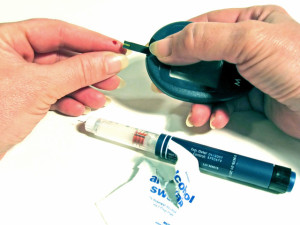Robert Waters MD
ABSTRACT
Mg Man Cal tiss-04-17-08
Serum/plasma measurements do not reflect magnesium deficits in clinical situations and magnesium load tests are used as a more accurate method to identify magnesium deficiency in a variety of disease states as well as in subclinical conditions. The objective of this study was to determine if people are indeed magnesium deficient or if the apparent magnesium deficiency is due to the composition of the infusate used in the load test.
Magnesium load tests were performed on 7 patients using three different Mg solution infusions- a Mg-EDTA (ethylene diamine tetraacetic acid)-nutrient cocktail used in EDTA chelation therapy containing several components including vitamins and minerals and the same cocktail without EDTA and an infusion of an identical amount of magnesium in normal saline solution. There was no significant difference in the amount of magnesium retained in the 24 hours after infusion among the three infusates. All infusates resulted in very high magnesium retention compared to previous published magnesium load studies. Magnesium deficiency may be widespread and the relationship of Mg deficiency to related diseases requires further study.
INTRODUCTION
Mg is the fourth most abundant cation in the body and its intracellular concentration is exceeded only by potassium [1]. Mg activates more than 300 enzymes in the human body [2]. Deficiency of Mg has been linked to a variety of clinical disease states including hypertension, myocardial infarction, cardiac dysrhythmias, coronary spasm and premature artherosclerosis [3]. In addition, patients with diabetes have been found to be at particular risk for Mg deficiency [4]. Conditions related to the deficiency of Mg may be linked to its functions as a cofactor for enzymes related to cell respiration, glycolysis and ion transport (e.g. Na-K-ATPase). In fact, the central position of Mg in its role in energy storage, transfer and utilization is mediated through its function in the formation of Mg-ATP, the ultimate form of stored energy in biological systems. In addition, Mg has functions related to protein synthesis through its action on nucleic acid polymerization, binding of ribosomes to RNA and the synthesis and degradation of DNA [5]. Mg is also an integral player in calcium biology via its ability to maintain low resting concentrations of intracellular calcium ions. It competes with calcium for membrane binding sites and as such has been described as a “calcium channel blocker” [6].
In degenerative diseases, Mg deficiency has been shown to be related to the generation of free radicals [7]. Mg deficiency has also been shown to negatively influence the generation of nitric oxide and therefore the impact of such deficiency may be responsible in part for the pathogenesis of endothelial dysfunction and its relationship to vascular disease, diabetes and other diseases associated with aging [8].
In a previous study, we showed that after the infusion of 686 mg of elemental Mg as Mg sulfate, in an EDTA chelation “cocktail”, 83% of the infused Mg was retained in the initial 24 hours following infusion [9]. This degree of retention of Mg has generally been recognized to represent evidence of severe Mg deficiency. However, in that study, it was not clear if the apparent Mg retention was due to a true Mg deficiency or if the components of the chelation cocktail affected Mg retention. Guldager et al. [10] infused 3 g of EDTA in saline, without any Mg, into a group of peripheral vascular disease patients and collected 24 hour urines of the patients and controls. There was a highly significant decrease in the Mg in the 24 hour urines of the EDTA patients vs the controls indicating that the EDTA increased Mg retention. The serum Mg in these patients did not increase so it is probable that the EDTA caused Mg to enter intracellular compartments. This present study was designed to determine the effects of components of the Mg infusates on Mg retention.
PATIENTS AND METHODS
The study was approved by the Clinic Human Studies Review Board, Wisconsin Dells, WI. The study was explained to the subjects and patients signed an informed consent before the study. Data are available to the participants upon request. Participants did not incur any medical fees as a result of their participation and were not paid for their participation.
At the onset of the study, patients were instructed in the accurate collection of 24-h urine specimens to avoid metal contamination. Twenty-four-hour urine samples were collected in 4-L sample containers (Fisher Scientific Co., Pittsburgh, PA) 2d prior to chelation therapy (d 1 and d 2), the day of chelation therapy (d 3), and the following day (d 4). Control urine samples were collected on Monday and Tuesday and the post-infusion urine samples on Wednesday and Thursday. In Phase 1 of the study, on Wednesday morning of the study week, an intravenous infusion of 2.25 g of EDTA mixed in sterile water with 5 g of sodium ascorbate, 2500 units of heparin, 3 mL of 2% procaine, 100mg pyridoxine HCl, 4 meq KCl, 1 mL of 8.4% sodium bicarbonate, 1000 µg hydroxycobalamin, 1 mL vitamin B complex, and 7 mL magnesium sulfate equivalent to 686 mg of elemental magnesium was given in an arm vein over a 2.5 hour period. During phase 2, patients received an identical infusion without any EDTA and during phase 3 subjects received 686 mg elemental Mg in saline [9] [11]. Order of the phases was random. The procedures were two to four weeks apart. Magnesium contents of the urine samples were measured and the Mg retention calculated using the following formula modified from Jeppesen [12]:
%Mg retention = [infused Mg – (urine Mg on day 3 – average urine Mg on days 1 and 2)/ infused Mg] X 100.
Day 3 was the following day after the infusion; days 1 and 2 were baseline days immediately preceding the infusion. In addition, Mg content was also measured on day 4.
Since the time of our original chelation study, published and anecdotal data have revealed that the clinical efficacy of EDTA chelation therapy could be achieved with a smaller dose of EDTA with fewer potential side effects. Therefore, we reduced the dose of EDTA to 2.25 g.
Magnesium concentrations in the urine were determined using flame atomic absorption using a Perkin-Elmer 5000 flame atomic absorption spectrometer using standard techniques (Perkin-Elmer, Norwalk, CT) and reference materials as described [13].
Statistics: Statistical analyses of the data were performed using 2-Way Analysis of Variance (SAS Institute, Cary, NC, version 9.1). The main effects were the variable components of the infusions in the 3 Phases. Values are mean ± SEM.
RESULTS
Means for magnesium losses among the three Phases were not statistically different. Approximately 70% of the infused Mg was retained during the 24-h period after the infusion (day 3) in Phase 1. Retention of Mg in Phases 2 and 3 were similar. By day 4, the 24-h Mg excretion was not significantly different from the averages of days 1 and 2 in all three Phases of the study.
DISCUSSION
In this study, Mg retention was greater than 70% for all infusates. High Mg retention is probably not due components of the infusate since infusion of Mg added to saline also led to significant Mg retention. The presence of EDTA in the cocktail did not increase the retention of Mg and retention was still approximately 72% when Mg sulfate was added to saline alone and infused. Suboptimal Mg status appears to be present in essentially all of the subjects.
From analyzing the data on Mg load tests published over the last 30 years, it appears that there is great variation in the percentage of Mg that can be expected to be retained by normal patients vs. patients with various medical conditions. It is clear that serum/plasma Mg measurements do not necessarily reflect Mg deficits in clinical situations [14]. Thus alternative measurements of Mg status were attempted and ultimately the Mg retention test was suggested as a more accurate method to identify Mg deficiency in a variety of disease states as well as in subclinical conditions. Other methods including bone Mg, muscle Mg, NMR spectroscopy, single ion channel analysis, leukocyte Mg, intraerythrocyte Mg and Mg balance studies are more expensive and/or invasive but may not be more informative than the Mg load test. Even the intracellular Mg measurements have shown inconsistent correlation with serum levels and other tissue levels as well as Mg load test data [15].
Table 2 summarizes the data from a number of intravenous load tests. In most of the studies, the demarcation in Mg retention between patients and controls is roughly 20%. In our present study, all groups of patients had Mg retention of at least 70%. The presence of EDTA at a dose of 2.25g in the infused Mg preparation did not explain the high retention since when EDTA was omitted from the infusate, Mg retention remained high. However, we cannot, with certainty, conclude that EDTA results in no greater Mg retention since we only used 2.25g of EDTA in the infusions vs the prior study of 3.0g which resulted in an even greater retention of 83% [9]. The results of Guldagner, et al also suggest a causal Mg retention by 3g of EDTA without any Mg added to the infusate [10].
Components of the infusate in the present study also appear to have little influence on magnesium retention since the Phase 2 Mg retention cocktail without EDTA, but otherwise the same vitamins and minerals, was not different from the cocktail containing only Mg and saline. Patients in our earlier study [9] all had evidence of degenerative diseases and retained even greater amounts of Mg than the patients in our present study and the dose of EDTA in that study was 3 g. Earlier studies of the therapeutic effects of EDTA used 5 g of EDTA per treatment, 5 days per week, and showed dramatic positive clinical effects as well as objective evidence of benefits such as improved EKG’s, reduction in the calcification of heart valves and dissolution of metastatic calcification in the kidneys [16] [17]. Only further studies on the dose dependent effects of EDTA as well as careful choice of “normal” vs. “diseased” patients can help resolve the issue of whether EDTA can influence calcium and magnesium dynamics in vivo in correlation with clinical and biochemical findings.
A number of studies using the Mg retention test have shown that patients with corornary heart disease are Mg deficient compared to controls. Jeppesen reasoned that Greenlanders have a lower rate of myocardial infarction as a result of their high serum Mg, low serum calcium and prolonged bleeding time (known to be induced by Mg administration) [12]. After administering 30 mmoles of intravenous Mg over 12 hours in patients with acute myocardial infarction, the infarction patients retained 42% of the infused Mg over the next 24 hours compared to only 22% in the control group. He also obtained quadricep muscle biopsies, which revealed an increased Mg content in the control group vs the acute myocardial infarction groups but differences were not statistically significant.
Sjogren et al. [18] showed patients with Crohn’s disease had lower tissue concentrations of Mg compared with controls and after IV infusions of 60 mmole Mg, the Crohn’s patients had significantly higher Mg retention than the controls. Gullestad et al. [19] showed that Mg retention in the 24 hour urine was 3-4% in a group of individuals without known predisposition for Mg deficiency after an infusion of 30 mmoles Mg sulfate. This was significantly lower than that for 661 hospitalized patients with known predisposition to Mg deficiency (cardiovascular disease, alcoholism, etc. whose percent retention varied from 16 – 38%). Interestingly, the serum Mg was similar in the patient groups and the controls except for the alcoholics, hypertensives and young healthy controls who had significantly reduced levels.
This later finding, particularly in reference to “young healthy” controls, brings up the probability that dietary intake of Mg is suboptimal and Western diets may be contributing to an increasing problem of Mg deficiency which may be a component of the growing epidemic of the metabolic syndrome and related diseases.
This possibility is supported by manuscripts of Resnick and associates spanning from 1984 to 2000 [20] [21]. Using Mg-specific selective ion electrode apparatus and 31P-NMR spectroscopy, there was a significant correlation between intracellular ionized Mg as well as intracellular free Mg and the presence of NIDDM [22]. Other studies reported increased intracellular calcium, decreased intracellular Mg and decreased cytosolic pH with the presence of essential hypertension [23]. A 1992 study revealed that oral glucose loading, even in normal subjects, elevates free calcium and suppresses free Mg [24]. These data suggest, in the author’s words, “an ionic hypothesis of cardiovascular and metabolic disease in which a generalized defect in cell ion handling is present in all tissues.” This trend leads to, in different tissues, the features of the metabolic syndrome, hypertension, obesity, insulin resistance and left ventricular hypertrophy, the latter related both to hypertension and, independently, vasoconstriction and increased contractility caused by high cytosolic calcium and lowered free Mg [24]. Arterial stiffness, as measured by High Frequency Ultrasound analysis, is known to correlate with hypertension and coronary heart disease [25]. Resnick et al. [26] showed, using direct magnetic resonance determination of aortic distensibility, that in essential hypertension, there are statistically significant correlations between fasting glucose, abdominal visceral fat and in situ intracellular Mg.
In a rat model, Barbagallo et al. [27] showed that glucose, at increasing mM concentrations, caused a significant increase in cytosolic free calcium in vascular smooth muscle. The authors suggest that these cellular effects of hyperglycemia may underlie the predisposition of patients with diabetes and patients with insulin resistance to hypertension and vascular diseases. The same group of investigators showed that aging itself is associated with the onset of the elevation of intracellular calcium and reduction of intracellular Mg that is indistinguishable from effects seen in essential hypertension and diabetes mellitus independent of age [28]. These changes may predispose older persons to cardiovascular and metabolic diseases.
Wells et al. [28] identified a previously unknown genetic defect in Mg metabolism in salt-sensitive essential hypertension. This Mg binding defect results in the inhibition of Mg entry into the cell thereby reducing Mg dependent enzymes from operating efficiently. The resulting lowering of Mg ATP results in the inability to extrude sodium ions and hypertension develops as a consequence of smooth muscle dysfunction. The authors also found the Mg binding defect was found in every one of 24 patients with type 2 diabetes suggesting that this defect in Mg transport may be a contributor to NIDDM. These findings are of possible importance when considered in conjunction with the studies described above [18] [21-24 [26] [27].
Gullestad et al. evaluated 88 healthy Norwegians ages 18 to 66 years using a 30 mmole intravenous Mg load test over 8 hours and measured the 24 hour urinary Mg excretion [29]. They found no correlation between Mg retention and serum Mg or basal urinary Mg. The Mg retention in these healthy patients was 10.6 to – 4%. The lowest and highest second standard deviation values were -19.5% and 27.5% respectively. This result agrees well with the above historical consensus.
Another study by Gullestad et al. [30] on “healthy free-living elderly Norwegians,” mean age 73 ± 6, using the same load test of 30 mmoles of Mg revealed a retention of 28% compared to 6% in younger controls. This finding also roughly agrees with the literature and is very interesting when considered in the light of the findings of Barbagallo et al. [27] that elderly people show intracellular calcium and Mg ion concentrations similar to those found in hypertensives and people with diabetes.
A study of Mg deficiency using the “short-term” Mg loading test by Rob et al. [31] revealed that even low dose (0.1 mmole Mg per Kg of body weight) infused over one hour was still able to differentiate Mg adequate patients from renal transplant patients with known Mg deficiency. After treatment with 5 mmoles of Mg per kilogram body weight for four months, a cohort of the latter group reduced their Mg retention from 47% on average to 16%. The placebo transplant patients continued to retain the infused Mg at 58% of the dose. The utility of this short-term, low dose Mg retention test can clearly help identify Mg deficiency and help ensure that patients are adequately repleted.
Finally, we could ask which tissue cells are the benefactors of the increased Mg retention in the patients studied. Bone may be a tissue compartment that may have taken up the infused magnesium since two-thirds of the total body Mg content is contained in skeletal tissue[32]. This is especially likely since it is known that the Mg content of bone falls with age [33] and in the osteoporotic state [34]. If the diet is Mg deficient and the small intestine and kidney can’t effectively increase Mg absorption, bone releases the element into the extra cellular fluid to maintain the serum level [35].
CONCLUSION
These data demonstrate that Mg deficiency may be widespread. The composition of the infusate used in magnesium load tests appears to have minimal influence on magnesium retention and does not explain the reported magnesium deficiency. The importance of dietary factors, especially Mg, in the causation of the present epidemic of metabolic syndrome and its associated complications calls for additional efforts to identify and treat patients at risk of magnesium deficiency.
Table 1: EDTA and cocktail effects on magnesium losses and retention on the day of the infusions (day 3) minus average of days 1 and 2
| SUBJECT # |
COCKTAIL |
COCKTAIL MINUS EDTA |
SALINE |
| 1 |
263 |
285 |
345 |
| 2 |
245 |
156 |
50 |
| 3 |
203 |
116 |
116 |
| 4 |
193 |
144 |
198 |
| 5 |
182 |
210 |
276 |
| 6 |
133 |
80 |
96 |
| 7 |
205 |
289 |
268 |
| MEAN ± SEM |
203 ± 16 |
182 ± 31 |
193 ± 41 |
| % Retention of infused magnesium |
70.3 ± 2.3 |
73.3 ± 4.5 |
71.9 ± 6.0 |
Values are mean ± SEM. All infusates contained 686 mg of Mg.
Values for COCKTAIL, COCKTAIL MINUS EDTA and SALINE are urinary magnesium losses (mg) on day 3 minus the average for days 1 and 2. There were no significant differences among the three different infusates tested.
Table 2: Intravenous magnesium load tests in patients and controls
| Reference |
Country |
Patients, Mg Retention, % |
Disease/Condition |
Controls, Mg Retention, % |
|
| Thoren [36] |
| Caddell et al. [37] |
| Bohmer & Mathiesen [38] |
| Ryzen et al. [39] |
| Fort & Lifshitz [40] |
| Jeppesen [12]Sjogren et al. [18] |
| Rasmussen et al. [41] |
| Martin [42] |
| Gullestad et al. [19] |
| Gullestad et al. [29] |
| Gullestad et al. [30] |
| Ozono et al. [43] |
| Toral Revuelta et al. [44] |
| Hebert et al. [45] |
| Papzachariou et al. [46] |
| Waters et al. [9] |
|
|
|
|
|
| Sweden |
| USA |
| Sweden |
| USA |
| USA |
| DenmarkSweden |
| Denmark |
| UK |
| Norway |
| Norway |
| Norway |
| Japan |
| Spain |
| Canada |
| UK |
| USA |
|
|
| >20 |
| 51.0 |
| 77.0 |
| 51.0 |
| 58.7 |
| 42.062 |
| 34.0 |
| 62.0 |
| 16-38 |
| No patients |
| 28.0 |
| 41.9 |
| 28.0 |
| 70.0 |
| 59.8 |
| 83.0 |
|
|
| G.I. fluid loss |
| Post partum women |
| Alcoholics |
| Alcoholics |
| IDDM children |
| MICrohn’s disease |
| IHD |
| Elderly |
| Various diagnoses |
| No patients |
| Elderly |
| Hypertension |
| Malnourished elderly |
| Intensive care patients |
| Pancreatitus |
| CAD/DM |
|
|
| NC* |
| NC |
| 22.6 |
| 15.0 |
| NC |
| 22.025 |
| 4.7 |
| NC |
| 3-4 |
| 6.3-10.3 |
| 6.0 |
| 31.8 |
| Not given |
| NC |
| 22.0 |
| NC |
|
Citations are in chronological order.
*NC denotes no controls.
ACKNOWLEDGEMENT
The authors would like to thank the late Dr. Mildred Seelig for her advice and encouragement during the initial stages of this study.
Reference List
- Burtis CA, Ashwood ER (1999) Tietz Textbook of Clinical Chemistry. WB Saunders Company, Orlando, FL
- Sauberlich HE (1999) Laboratory Tests for the Assessment of Nutritional Status. CRC Press, Boca Raton, FL
- Selig MS (1980) Magnesium Deficiency in Pathogenesis of Disease. Plenum Medical Book Co, New York, NY
- Walti MK, Zimmermann MB, Walczyk T, Spinas GA, Hurrell RF (2003) Measurement of magnesium absorption and retention in type 2 diabetic patients with the use of stable isotopes. Am J Clin Nutr 78:448-453
- al-Ghamdi SM, Cameron EC, Sutton RA (1994) Magnesium deficiency: pathophysiologic and clinical overview. Am J Kidney Dis 24:737-752
- Taranenteo VM (1991) Efficacy of vascular wall protection from atherosclerotic damage using various calcium antagonists. Patol Fiziol Eksp Ter 31:5-7
- Weglicki WB, Mak IT, Kramer JH, Dickens BF, Cassidy MM, Stafford RE, Philips TM (1996) Role of free radicals and substance P in magnesium deficiency. Cardiovasc Res 31:677-682
- Mak IT, Komarov AM, Wagner TL, Stafford RE, Dickens BF, Weglicki WB (1996) Enhanced NO production during Mg deficiency and its role in mediating red blood cell glutathione loss. Am J Physiol 271:C385-C390
- Waters RS, Bryden NA, Patterson KY, Veillon C, Anderson RA (2001) EDTA chelation effects on urinary losses of cadmium, calcium, chromium, cobalt, copper, lead, magnesium, and zinc. Biol Trace Elem Res 83:207-221
- Guldager B, Jorgensen PJ, Grandjean P (1996) Metal excretion and magnesium retention in patients with intermittent claudication treated with intravenous disodium EDTA. Clin Chem 42:1938-1942
- Anderson RA, Bryden NA, Waters R (1999) EDTA chelation therapy does not selectively increase chromium losses. Biol Trace Elem Res 70:265-272
- Jeppesen BB (1986) Magnesium status in patients with acute myocardial infarction: a pilot study. Magnesium 5:95-100
- Anderson RA, Polansky MM, Bryden NA (1984) Strenuous running: acute effects on chromium, copper, zinc and selected clinical variables in urine and serum of male runners. Biol Trace Elem Res 6:327-336
- Gitelman HJ, Welt LG (1969) Magnesium deficiency. Annu Rev Med 20:233-42:233-242
- Durlach J (1992) New trends in international magnesium research. Magnes Res 5:1-4
- Clarke NE, Clarke CN, Mosher RE (1955) The “in vivo” dissolution of metastatic calcium. American Journal Medical Science 229:142-146
- (1956) Treatment of Angina Pectoris with disodium ethylene diamine tetraacetic acid. Journal Medical Science 232:22-34
- Sjogren A, Floren CH, Nilsson A (1988) Evaluation of magnesium status in Crohn’s disease as assessed by intracellular analysis and intravenous magnesium infusion. Scand J Gastroenterol 23:555-561
- Gullestad L, Dolva LO, Waage A, Falch D, Fagerthun H, Kjekshus J (1992) Magnesium deficiency diagnosed by an intravenous loading test. Scand J Clin Lab Invest 52:245-253
- Resnick LM, Gupta RK, Laragh JH (1984) Intracellular free magnesium in erythrocytes of essential hypertension: relation to blood pressure and serum divalent cations. Proc Natl Acad Sci 81:6511-6515
- Barbagallo M, Gupta RK, Dominguez LJ, Resnick LM (2000) Cellular ionic alterations with age: relation to hypertension and diabetes. J Am Geriatr Soc 48:1111-1116
- Resnick LM, Altura BT, Gupta RK, Laragh JH, Alderman MH, Altura BM (1993) Intracellular and extracellular magnesium depletion in type 2 (non-insulin-dependent) diabetes mellitus. Diabetologia 36:767-770
- Resnick LM (1992) Cellular ions in hypertension, insulin resistance, obesity, and diabetes: a unifying theme. J Am Soc Nephrol 3:S78-S85
- Resnick LM (1992) Cellular calcium and magnesium metabolism in the pathophysiology and treatment of hypertension and related metabolic disorders. Am J Med 93:11S-20S
- Yufu K, Takahashi N, Anan F, Hara M, Yoshimatsu H, Saikawa T (2004) Brachial arterial stiffness predicts coronary atherosclerosis in patients at risk for cardiovascular diseases. Jpn Heart J 45:231-242
- Resnick LM, Militianu D, Cunnings AJ, Pipe JG, Evelhoch JL, Soulen RL (1997) Direct magnetic resonance determination of aortic distensibility in essential hypertension: relation to age, abdominal visceral fat, and in situ intracellular free magnesium. Hypertension 30:654-659
- Barbagallo M, Resnick LM, Dominguez LJ, Licata G (1997) Diabetes mellitus, hypertension and ageing: the ionic hypothesis of ageing and cardiovascular-metabolic diseases. Diabetes Metab 23:281-294
- Wells IC, Agrawal DK, Anderson RJ (2004) Abnormal magnesium metabolism in etiology of salt-sensitive hypertension and type 2 diabetes mellitus. Biol.Trace Elem Res 98:97-108
- Gullestad L, Midtvedt K, Dolva LO, Norseth J, Kjekshus J (1994) The magnesium loading test: reference values in healthy subjects. Scand J Clin Lab Invest 54:23-31
- Gullestad L, Nes M, Ronneberg R, Midtvedt K, Falch D, Kjekshus J (1994) Magnesium status in healthy free-living elderly Norwegians. J Am Coll Nutr 13:45-50
- Rob PM, Dick K, Bley N, Seyfert T, Brinckmann C, Hollriegel V, Friedrich HJ, Dibbelt L, Seelig MS (1999) Can one really measure magnesium deficiency using the short-term magnesium loading test? J Intern Med 246:373-378
- Martini LA (1999) Magnesium supplementation and bone turnover. Nutr Rev 57:227-229
- Tohno S, Tohno Y, Masuda M, Minami T, Moriwake Y, Utsumi M, Yamada M (1999) A possible balance of magnesium accumulations among bone, cartilage, artery, and vein in single human individuals. Biol Trace Elem Res 70:233-241
- Matsuzaki H (2006) [Prevention of osteoporosis by foods and dietary supplements. Magnesium and bone metabolism]. Clin Calcium 16:1655-1660
- Laires MJ, Monteiro CP, Bicho M (2004) Role of cellular magnesium in health and human disease. Front Biosci 9:262-276
- Thoren L (1963) Magnesium deficiency in gastrointestinal fluid loss. Acta Chir Scand 10:Suppl 306-Suppl 365
- Caddell JL, Saier FL, Thomason CA (1975) Parenteral magnesium load tests in postpartum American women. Am J Clin Nutr 28:1099-1104
- Bohmer T, Mathiesen B (1982) Magnesium deficiency in chronic alcoholic patients uncovered by an intravenous loading test. Scand J Clin Lab Invest 42:633-636
- Ryzen E, Elbaum N, Singer FR, Rude RK (1985) Parenteral magnesium tolerance testing in the evaluation of magnesium deficiency. Magnesium 4:137-147
- Fort P, Lifshitz F (1986) Magnesium status in children with insulin-dependent diabetes mellitus. J Am Coll Nutr 5:69-78
- Rasmussen HS, McNair P, Goransson L, Balslov S, Larsen OG, Aurup P (1988) Magnesium deficiency in patients with ischemic heart disease with and without acute myocardial infarction uncovered by an intravenous loading test. Arch Intern Med 148:329-332
- Martin BJ (1990) The magnesium load test: experience in elderly subjects. Aging (Milano) 2:291-296
- Ozono R, Oshima T, Matsuura H, Higashi Y, Ishida T, Watanabe M, Yoshimura M, Hiraga H, Ono N, Kajiyama G (1995) Systemic magnesium deficiency disclosed by magnesium loading test in patients with essential hypertension. Hypertens Res 18:39-42
- Toral R, Jr., Martinez HD, Martinez RM, Llobell SG, Peralba Vano JI, Ribera Casado JM (1996) Intravenous magnesium load test in elderly patients with protein-energy malnutrition. Magnes Res 9:293-298
- Hebert P, Mehta N, Wang J, Hindmarsh T, Jones G, Cardinal P (1997) Functional magnesium deficiency in critically ill patients identified using a magnesium-loading test. Crit Care Med 25:749-755
- Papazachariou IM, Martinez-Isla A, Efthimiou E, Williamson RC, Girgis SI (2000) Magnesium deficiency in patients with chronic pancreatitis identified by an intravenous loading test. Clin Chim Acta 302:145-154
Address all correspondence to:
Dr. Robert S. Waters, Waters Preventive Medical Center, PO Box 357,Wisconsin Dells, WI 53965, Phone: 608-254-7178, FAX: 608-253-7139, Email: sarah@watershealthcenter.com








